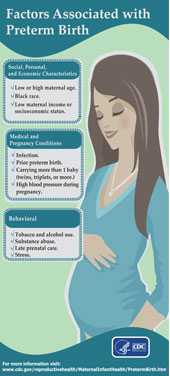Preterm Birth

Preterm birth is when a baby is born too early, before 37 weeks of pregnancy have been completed. In 2015, preterm birth affected about 1 of every 10 infants born in the United States. Preterm birth rates decreased from 2007 to 2014, and CDC research shows that this decline is due, in part, to declines in the number of births to teens and young mothers. But, more recent data indicate a slight increase in the national preterm birth rate from 2014 to 2015. And, while it’s too early to know what caused this increase or if this is the start of trend, we do know that racial and ethnic disparities persist. In 2015, the rate of preterm birth among African-American women (13%) was about 50 percent higher than the rate of preterm birth among white women (9%).
A developing baby goes through important growth throughout pregnancy─ including in the final weeks and months. For example, the brain, lungs, and liver need the final weeks of pregnancy to fully develop. Read Your Baby Grows Throughout Your Entire Pregnancy [PDF-312KB]. There is a higher risk to the baby of serious disability or death when the baby is born early. In 2013, about one third (36%) of infant deaths were due to preterm-related causes. Babies who survive may have
- Breathing problems
- Feeding difficulties
- Cerebral palsy
- Developmental delay
- Vision problems [PDF – 118KB]
- Hearing impairment
Preterm births may also take an emotional toll and be a financial burden for families.
Frequently Asked Questions: For Women and Their Families
Are some women more likely than others to deliver early?
 Download this preterm birth infographic [PDF – 2.3MB]
Download this preterm birth infographic [PDF – 2.3MB]
Many times we do not know what causes a woman to deliver early, but several known factors may increase the likelihood that a woman delivers early. This preterm birth infographic [PDF – 2.3MB] gives some examples of these factors by medical and pregnancy conditions, behavioral factors, and social, personal, and economic characteristics.
What are the warning signs of preterm labor?
In most cases, preterm labor (labor that happens too soon, before 37 weeks of pregnancy) begins unexpectedly and the cause is unknown. Like regular labor, signs of early labor are—
- Contractions (the abdomen tightens like a fist) every 10 minutes or more often
- Change in vaginal discharge (a significant increase in the amount of discharge or leaking fluid or bleeding from the vagina)
- Pelvic pressure—the feeling that the baby is pushing down
- Low, dull backache
- Cramps that feel like a menstrual period
- Abdominal cramps with or without diarrhea
What should I do if I think I’m experiencing preterm labor?
If you think you are experiencing preterm labor, it is important that you see an healthcare provider right away. If you are having preterm labor, your provider may be able to give you medicine so that the baby will be healthier at birth.
Can anything be done to prevent a preterm birth?
Preventing preterm birth remains a challenge because there are many causes of preterm birth, and because causes may be complex and not always well understood. However, pregnant women can take important steps to help reduce their risk of preterm birth and improve their general health. These steps are to—
- Quit smoking. For help in quitting, call 1-800-QUIT-NOW (1-800-784-8669) or visit Tobacco Use and Pregnancy: Resources
- Avoid alcohol and illicit drugs
- Get prenatal care as soon as you think you may be pregnant and throughout the pregnancy
- Seek medical attention for any warning signs or symptoms of preterm labor
- Talk with your doctor or other healthcare provider about the use of progesterone treatment if you had a previous preterm birth
Another step women and their partners can take to reduce the risk of preterm birth is to achieve ideal length of time between pregnancies (birth spacing).
I used in vitro fertilization (IVF) or another assisted reproductive technology (ART) to get pregnant. What is my risk of having a preterm birth?
Women who conceive through ART are at higher risk for preterm birth, primarily because they are more likely to be pregnant with more than one baby at a time. More detailed information on ART and preterm birth can be found in the CDC’s 2015 Assisted Reproductive Technology Report [PDF – 5MB].
Is it okay to schedule my baby’s birth before 39 weeks of pregnancy?
Important growth and development occur throughout pregnancy—all the way through the final few weeks. Unless there is a medical need, delivery should not be scheduled before 39 weeks of pregnancy. Read: Your Baby Grows Throughout Your Entire Pregnancy [PDF-312KB].
What is CDC’s Division of Reproductive Health doing to prevent preterm birth?
CDC’s Division of Reproductive Health is engaged in a variety of research and science to practice activities aimed at understanding and reducing preterm birth. CDC scientists are collaborating with many partners, including state health departments, university researchers, and other health care professionals to understand why preterm births occur and what can be done to help prevent them. Read about our preterm birth activities.

Related Links
- Video: Is It Worth It? Watch this video from the National Child and Maternal Health Education Program to learn the benefits of waiting until 39 weeks to deliver.
- Preterm Birth (March of Dimes) The March of Dimes launched the Prematurity Campaign to address the issue and help families have full-term, healthy babies.
- Preterm Labor and Birth (ACOG) [PDF – 282KB] This patient education pamphlet was developed by the American College of Obstetricians and Gynecologists (ACOG).
- Page last reviewed: October 17, 2017
- Page last updated: October 17, 2017
- Content source:


 ShareCompartir
ShareCompartir